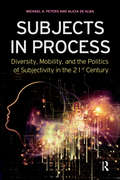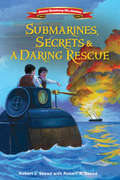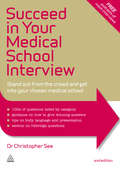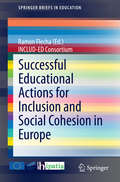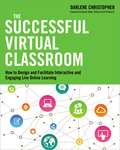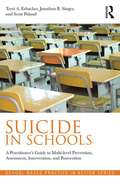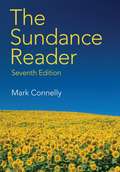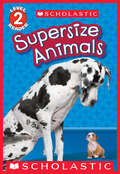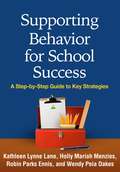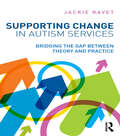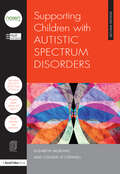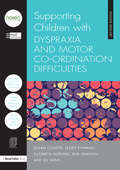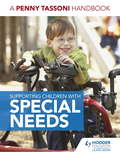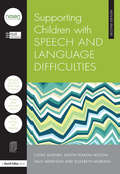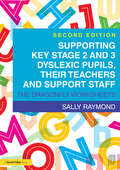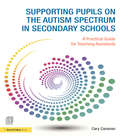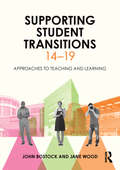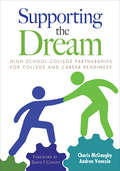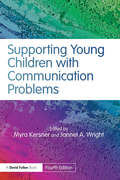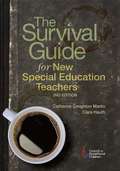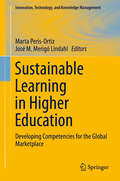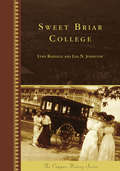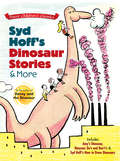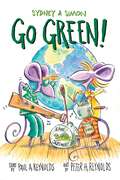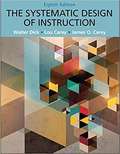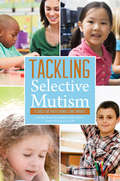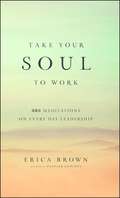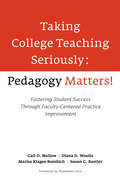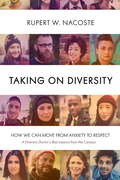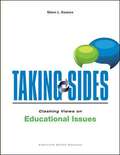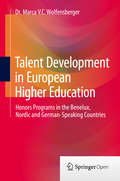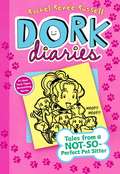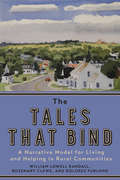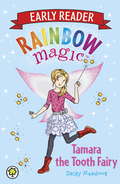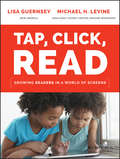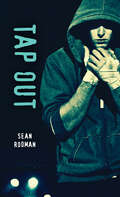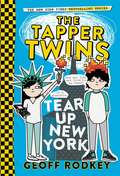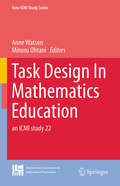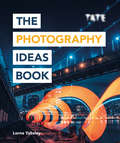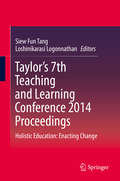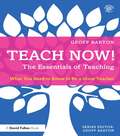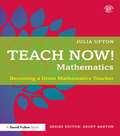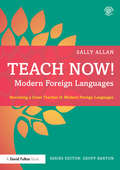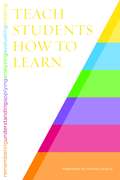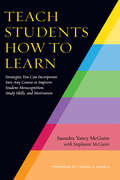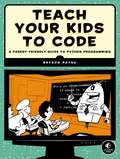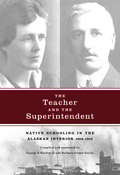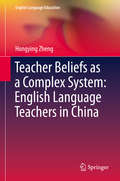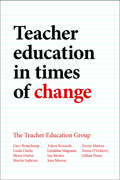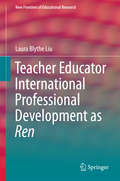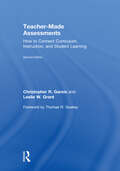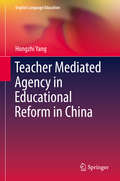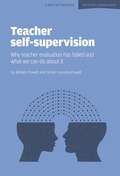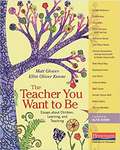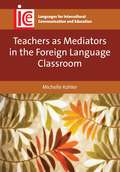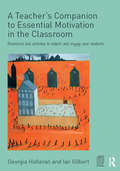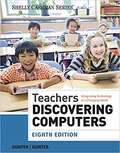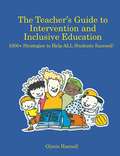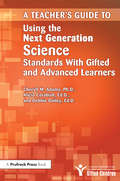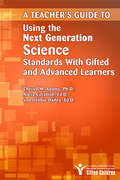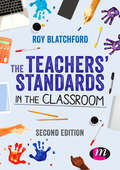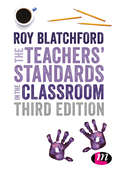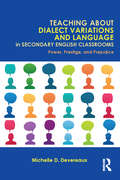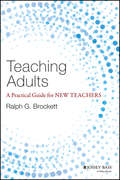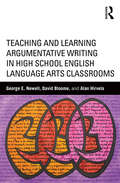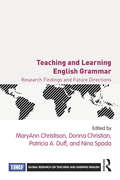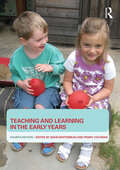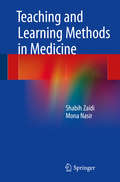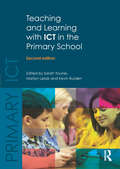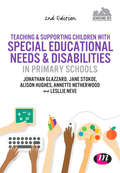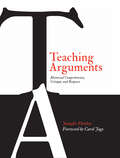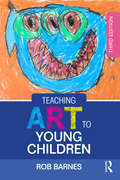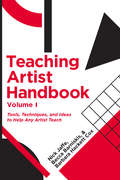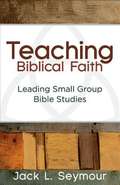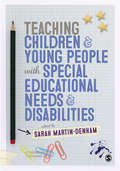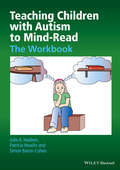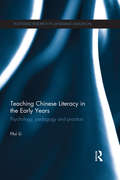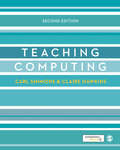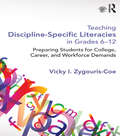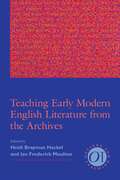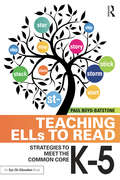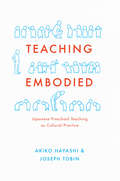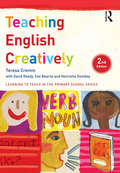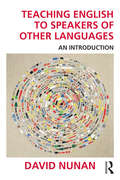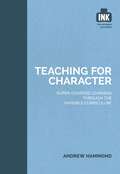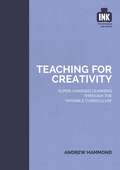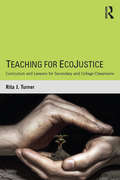- Table View
- List View
Subjects in Process
by Michael A. Peters Alicia de AlbaSubjects in Process investigates the human subject in the first decade of the twenty-first century in relation to changing social circumstances and belongings. The concept of 'subjectivity' in the Western tradition has focused on the figure of the autonomous, self-conscious, and rooted individual. This book develops a conception of the subject that is nomadic and fluid rather than grounded and complete. Written from a perspective that takes account of globalisation - and the pressures that it places upon individuals and communities - this book draws upon Nietzsche and the post-modern thinkers that followed him. Arguing that a modern conception of the subject must be one based on cultural exchanges and transformations, this book is sure to provide new insights for anyone concerned with or interested in the identity of the individual now and in the future.
Submarines, Secrets and a Daring Rescue
by Robert A. Skead Robert J. SkeadIn this second book in the American Revolutionary War Adventure series, Submarines, Secrets and a Daring Rescue, twins Ambrose and John Clark find themselves volunteering for another mission to help the newly forming United States. Inspired by their success in delivering a secret message to General George Washington himself, the boys step up to help transport much-needed gunpowder to the patriots and end up in an even more dangerous situation, trying to man one of the first submarines and then, later, attempting a prison break to rescue one of their older brothers. Follow
Succeed in Your Medical School Interview
by Dr Christopher SeeAfter completing the medical school application comes the last, and often most challenging aspect of the school selection process; the interview. Notoriously hard to prepare for, it's difficult to know what to read, what questions might be asked and how to answer them. How to Succeed In Your Medical School Interview de-mystifies the interview process. It provides clear guidelines and a unique framework; giving you the relevant points to consider while crucially leaving conclusions open to express your own opinions and personality. It provides a systematic and methodical process which enables you to mine information from examiners, whilst demonstrating your academic ability. With a huge bank of questions covering all aspects of the interview spectrum, including a specific section of Oxbridge questions, you will learn how to prepare, how to present yourself and most importantly, what to say.
Success in Professional Experience
by Dyson, Michael and Plunkett, Margaret and McCluskey, Kerryn Michael Dyson Margaret Plunkett Kerryn MccluskeySuccess in Professional Experience has been specifically designed to assist pre-service teachers on their journey to become successful learners and teachers during the practicum component of their degree. The authors present ideas on how to develop fundamental knowledge, skills and competencies, which help to build meaningful and sustainable relationships within educational communities. Each chapter explores a different area of professional experience, including observations, expectations, mentoring, reflective practice and portfolios. There are specific chapters on areas that students often find the most challenging such as: classroom management, ethics and working with diverse student populations, as well as a chapter catering for pre-service teachers coming from a non-English speaking background. Success in Professional Experience is suitable for early childhood, primary and secondary contexts and addresses the learning needs of on-campus and distance education students. It is also a useful guide for the university liaison staff and school based mentors of pre-service teachers.
Successful Educational Actions for Inclusion and Social Cohesion in Europe
by Ramon FlechaThis monograph analyses and describes successful educational actions with a specific focus on vulnerable groups (i. e. youth, migrants, cultural groups e. g. Roma, women, and people with disabilities). Concrete data that shows success in school performance in subject matters such as math or language will be provided, as well as children, teachers and families accounts of the impact of this success. Alongside, there is an analysis of the relationship between these children's educational performance with their inclusion or exclusion from different areas of society (i. e. housing, health, employment, and social and political participation). Many studies have already diagnosed and described the causes of educational and social exclusion of these vulnerable groups. This monograph, however, provides solutions, that is, actions for success identified through the INCLUD-ED project, thus providing both, contrasted data and solid theoretical background and development. Some examples of these actions are interactive groups (or heterogeneous grouping in the classroom with reorganisation of human resources), extension of the learning time, homework clubs, tutored libraries, family and community educative participation, family education, or dialogic literary gatherings. All these actions have been defined as successful educational actions, which mean that they lead to both efficiency and equity. Finally, recommendations for policy and practice are included and discussed.
The Successful Virtual Classroom: How to Design and Facilitate Interactive and Engaging Live Online Learning
by Darlene ChristopherVirtual training gives learning professionals unprecedented flexibility, making it possible to reach participants globally and unite physically dispersed teams. But designers and facilitators must adapt their programs and delivery styles in order to be effective in this new medium. The Successful Virtual Classroom goes beyond introducing the technology, to offer trainers proven techniques tailored specifically to engage live online audiences. Packed with easy-to-use tools, checklists, and worksheets--as well as case studies from Oracle, UPS, and more--the book introduces the PREP model for planning, rehearsing, executing, and then conducting a post mortem following the training event. Readers will learn how to: Make themost of virtual classroom features such as content and screen sharing,annotation tools, polls, and breakout rooms * Weave chat responses into the discussion * Compensate for the absence of body language * Monitor feedback * Engage individuals with different learning styles * Encourage audience contribution * Meet the unique needs of global participants * And more Featuring icebreakers and interactive exercises designed for an online environment, this book helps readers create programs that truly drive learner engagement.
Suicide in Schools: A Practitioner's Guide to Multi-level Prevention, Assessment, Intervention, and Postvention (School-based practice in action series)
by Scott Poland; Jonathan B. Singer; Terri A. ErbacherThe authors include detailed case examples, innovative approaches for professional practice, usable handouts, and internet resources on the best practice approaches to effectively work with youth who are experiencing a suicidal crisis as well as those students, families, school staff, and community members who have suffered the loss of a loved one to suicide.
The Sundance Reader, 7th edition
by Mark ConnellyTHE SUNDANCE READER, Seventh Edition, features more than 70 concise yet distinct essays drawn from a range of academic disciplines and professions to appeal to a variety backgrounds and interests. Combining classic and contemporary, traditional and provocative, this rich collection of engaging essays and articles emphasizes critical thinking, careful analysis, and effective writing and composition skills. Topics are as varied as the environment, culture, social issues, the media, and business. Selections include works by William Safire, Jessica Valenti, Robert Reich and Al Gore.
Supersize Animals (Scholastic Reader, Level 2)
by Melvin Berger Gilda BergerA level 2 reader in the Scholastic nonfiction reader line featuring gigantic animals that you'll hardly believe are real!Some people are short and some people are tall, but everyone is a little different. The same is true for animals. Some animals are small and others are bigger. But did you know that certain animals grow much, MUCH larger than all others of their kind? In this level 2 reader, you'll meet oversized animals--from rabbits the size of dogs, and dogs the size of horses and so much more. They are the supersize animals!
Supporting Behavior For School Success: A Step-by-Step Guide To Key Strategies
by Kathleen Lane Holly Menzies Robin Ennis Wendy OakesDesigned for busy teachers and other school-based professionals, this book presents step-by-step guidelines for implementing seven highly effective strategies to improve classroom management and instructional delivery. These key low-intensity strategies are grounded in the principles of positive behavior intervention and support (PBIS), and are easy to integrate into routine teaching practice. Chapters discuss exactly how to use each strategy to decrease disruptive behavior and enhance student engagement and achievement. Checklists for success are provided, together with concise reviews of the evidence base and ways to measure outcomes. Illustrative case examples span the full K-12 grade range. Reproducible intervention tools can be downloaded and printed in a convenient 8 1/2" x 11" size. See also Managing Challenging Behaviors in Schools, by Kathleen Lynn Lane et al., which shows how these key strategies fit into a broader framework of prevention and intervention.
Supporting Change in Autism Services: Bridging the gap between theory and practice
by Jackie RavetSupporting Change in Autism Services explores the theoretical and practical dimensions of improving service provision for children, young people and adults with autism. The core aim of the book is to identify and critically examine some of the key factors that either facilitate or inhibit the implementation of good autism practice at both practitioner level and workplace level. It shows practitioners and students how to successfully translate autism theory into practice across service contexts and showcases a range of practitioner case studies throughout the text in order to illustrate effective implementation.? Topics explored include: controversies and ambiguities in autism policy, theory and discourse; understanding autism in an inclusive context; enabling participation; making sense of behaviour; autism and interprofessionalism; strategic planning for autism friendly services; bridging the implementation gap. This book is essential reading for anyone interested in improving services for people with autism in the education, social care, health and voluntary sectors.
Supporting Children with Autistic Spectrum Disorders (21st Century Business Management)
by Hull City CouncilThis practical resource contains a wealth of valuable advice and tried-and-tested strategies for identifying children and young people with Autistic Spectrum Disorders (ASD). This fully updated text describes the different types of difficulties experienced by pupils with ASD and helps practitioners to understand their diverse needs. This fully updated new edition explores key topics, including: organizing the classroom and support staff home-school liaison and working with siblings transition to adulthood independence skills whole school implications. Now fully updated in line with the SEND 2014 Code of Practice, this invaluable guide provides guidance and practical strategies for teachers and other professionals, helping them to feel more confident, and be more effective in supporting learners in a variety of settings. For professional development, this book also provides materials for in-house training sessions, and features useful checklists, templates and photocopiable/downloadable resources.
Supporting Children with Dyspraxia and Motor Co-ordination Difficulties (nasen spotlight)
by Hull City Council Susan Coulter Lesley Kynman Elizabeth MorlingCompletely revised and updated in light of the new SEND 2014 Code of Practice, this new edition supports teachers in making good provision for children and young people with a range of co-ordination difficulties. Offering practical tips and strategies on how to meet the needs of children and young people with dyspraxia and other coordination difficulties in a range of educational settings, this book features timesaving checklists, templates and photocopiable resources to support professional development. The wide-ranging and accessible chapters explore topics including: Identification of different types of motor co-ordination difficulties Implications for classroom practice Understanding core skill development Assessment practices Written by practitioners, for practitioners, it also contains a wealth of tried and tested strategies and provides clear best-practice guidance for developing outstanding provision in inclusive settings. Susan Coulter – Senior Support Teacher for the Education Service for Disability at Hull City Council, UKLesley Kynman - Senior Support Teacher for the Education Service for Disability at Hull City Council. UKElizabeth Morling - SEN consultant and series editorRob Grayson – Team Leader, Integrated Physical and Sensory Services at Hull City Council, UKJill Wing – Senior Support Teacher, Integrated Physical and Sensory Services at Hull City Council, UK
Supporting Children with Special Needs: A Penny Tassoni Handbook
by Penny TassoniSupport the individual needs of children with this practical and informative guide from Penny TassoniFully matched to the new 2014 Special Education Needs and Disability Code of Practice, this Penny Tassoni Handbook explores supporting children with individual needs, working with parents and the issues surrounding SEN and disability. Tassoni's signature style and approach ensures that the government code is translated into a practical, informative and easy-to-read guide for anyone working in the role of a SENCO.- Helps you tailor your strategies in the key areas of communication & interaction, cognition & learning, social, emotional & mental health and sensory and/or physical needs.- Includes a detailed reference section on a wide range of specific needs from autism spectrum condition through to Fragile X.- Uses colourful design and illustrative photos which make theory easy to understand and to put into practice in real world scenarios.- Written in Penny Tassoni's easy-to-read, informative and practical style.
Supporting Children with Speech and Language Difficulties (nasen spotlight)
by Hull City CouncilCompletely revised and updated in light of the new SEND 2014 Code of Practice, this new edition describes the different types of difficulties experienced by pupils with speech, language and communication needs. It will help teachers and other professionals to feel more confident by providing expert guidance and practical strategies, and as a professional development tool, will also encourage outstanding practice by suggesting ideas and materials for in-house training sessions. The wide-ranging and accessible chapters explore topics including: Listening skills Phonological awareness Comprehension of language Activities for circle time Working with parents Featuring useful checklists, templates and photocopiable resources, this practical resource contains a wealth of valuable advice and tried-and-tested strategies for identifying children and young people with speech, language and communication needs, ensuring they have the support they need to make exceptional progress.
Supporting Key Stage 2 and 3 Dyslexic Pupils, their Teachers and Support Staff: The Dragonfly Worksheets
by Sally Raymond'I have found Sally Raymond's worksheets ideally suited for use with pupils in need of focussed literacy development materials. They find them varied and accessible with opportunities to include personal interests and topics. I use them to match specific learning needs to activities which introduce, explain, engage and assess individual targets and skills.' Julia Smith B.Ed. SpLD APC (Patoss) - dyslexia assessor and tutor This A4 resource book provides all the materials required to follow structured programmes of learning support for dyslexic pupils. Created by Sally Raymond, an experienced teacher of dyslexic pupils, this resource provides a wide variety of adaptable worksheets with lots of teaching advice and supportive guidance. The worksheets: are fully adaptable to meet the needs of different pupils support Department of Education recommendations and Ofsted advice and guidance encourage cross-curricula support and interventions to promote maximum access to a wide range of topics use varied, enjoyable, applications including games, quizzes and novel challenges designed to engage and stimulate thinking and learning develop the knowledge and skills of practitioners helping them identify and monitor progress and needs Also available by Sally Raymond: Extending Support for Key Stage 2 and 3 Dyslexic Pupils, their Teachers and Support Staff: The Dragonfly Games 978-1-13-877460-5 Spelling Rules, Riddles and Remedies 978-0-415-71000-8
Supporting pupils on the Autism Spectrum in Secondary Schools: A Practical Guide for Teaching Assistants
by Carolyn CanavanWritten to meet the needs of teaching assistants and learning support assistants, this book provides a practical toolkit for supporting students on the autistic spectrum in mainstream secondary schools. The book offers a clear, jargon free explanation of autism spectrum conditions and examines the difficulties arising from these conditions and how they can impact on students’ learning. Addressing issues which arise on a daily basis, it is full of practical advice and strategies for supporting students socially and academically across all areas of the curriculum. Features include: templates to scaffold students’ comprehension and learning in different subject areas forms to help with information collection and evaluation advice on supporting students through examinations examples and case studies to illustrate how the strategies described work in practice Packed with photocopiable resources that can be adapted to suit individual students’ needs, this book is essential reading for teaching assistants that want to help their students’ on the autistic spectrum to reach their full potential.
Supporting Student Transitions 14–19: Approaches to teaching and learning
by John Bostock Jane WoodSupporting Student Transitions 14-19 offers transition focused approaches to planning, teaching, learning and assessment designed to meet the needs of these unique learners. Drawing upon the latest research and theory, as well as the authors’ extensive experience in the field, it examines in detail transitions in teaching and learning in this complex sector. Drawing out and critically analysing the key features of both pedagogy and andragogy, the book presents the best elements of each to provide all tutors and practitioners involved in the teaching of 14-19 learners with clear strategies for supporting this group. Practical advice backed by sound theory will provide readers with a clear understanding of the requirements and needs of learners in the school, college and university. Topics explored include: ???? The role of the teacher in supporting student transitions ???? Understanding transition focused approaches Emotional and social factors involved ????Recognising difficulties and helping students prepare Supporting Student Transitions 14-19 is a practical guide also offering a unique contribution to the discourse on this important sector of education, increasingly afforded the attention it deserves. It will be an essential resource for trainee teachers, students of PCET, lecturers and teachers wanting to build upon their understanding of this group of learners.
Supporting the Dream: High School-College Partnerships for College and Career Readiness
by Charis L. McGaughy Dr Andrea VeneziaEducational partnerships for postsecondary readiness – your resource guide is here! This step-by-step action plan from college and career readiness experts, McGaughy and Venezia provides key research findings, real-world examples and reflections, and templates to help guide and structure the work of local and regional education partnerships. Get actionable information and practical strategies to help you: Identify needs Leverage existing relationships, programs and resources Build and sustain regional and local partnerships among individual school districts and postsecondary institutions Communicate and work across partnerships to support student learning and successful transitions This guide supports the development of strong relationships, aligned structures and comprehensive strategies to support student success.
Supporting the Dream: High School-College Partnerships for College and Career Readiness
by Charis L. McGaughy Dr Andrea VeneziaEducational partnerships for postsecondary readiness – your resource guide is here! This step-by-step action plan from college and career readiness experts, McGaughy and Venezia provides key research findings, real-world examples and reflections, and templates to help guide and structure the work of local and regional education partnerships. Get actionable information and practical strategies to help you: Identify needs Leverage existing relationships, programs and resources Build and sustain regional and local partnerships among individual school districts and postsecondary institutions Communicate and work across partnerships to support student learning and successful transitions This guide supports the development of strong relationships, aligned structures and comprehensive strategies to support student success.
Supporting Young Children with Communication Problems
by Myra Kersner Jannet A. WrightNow in its fourth edition, formerly published as How to Manage Communication Problems in Young Children, this invaluable guide to understanding and helping children whose speech and/or language is delayed or impaired has been completely revised and updated, and provides readers with: Practical advice on how to recognise communication problems Strategies for supporting children with speech, language and communication needs Best practice guide for parents and professionals working in partnership Contributions from a wide-range of specialist speech and language therapists Reflecting new developments and current practice, this book is of interest to parents, early years’ practitioners, students in education and speech and language therapy, and anyone interested in pursuing a career with young children in the foundation years. Written in an accessible style, it assumes no prior knowledge and includes a range of practical suggestions for dealing with children with all kinds of communication difficulties.
The Survival Guide for New Special Education Teachers
by Catherine Creighton Martin Clara HauthThe second edition of The Survival Guide for New Special Education Teachers is a must-have handbook for all new teachers both those in special education and those teaching in general education inclusive classrooms. The best part is the personal commentary and opportunities for reflection strategically placed throughout the guide. They make you feel like you have a mentor there to help you every step of the way.
Sustainable Learning
by Lorraine Graham Jeanette Berman Anne Bellert Lorraine Graham Jeanette BermanSustainable Learning: Inclusive Practices for 21st Century Classrooms provides readers with the knowledge and skills to be confident and effective inclusive teachers. The authors show that these skills are essential to quality teaching – teaching that is evidence-based, purposeful, relevant and responsive to students' needs. The book employs three overarching frameworks to examine inclusive practices in education: equity (learning for all), values (learning that matters) and sustainability (learning that lasts). It encourages teachers to see all students as developing learners and to consider the complexities and diversity of learning in the 21st century. In doing so, it canvasses topics such as a sustainable approach to inclusion, learning processes, teaching processes, differentiation, assessment to support teaching and learning, and life-long learning. Chapter features include: • 'Think and do' exercises • Examples, case studies and vignettes • Tables, figures and diagrams to help readers visualise core ideas, theories and themes
Sustainable Learning in Higher Education
by Marta Peris-Ortiz José M. Merigó LindahlIn an era of globalization, technological innovation, and social transformations, universities face the challenge of training students with the competencies needed to meet the demands of the market and to successfully integrate into today's workforce. This book looks at the university as a dynamic source of essential competencies and explores various skill management models, methodologies and innovations applied by educational institutions around the world. The demands of today's society represent a major challenge for universities and their teaching staffs. Professors need to adapt their teaching methods to meet these new challenges. For example, universities need to prepare new generations of students with the ability to select, update and use knowledge, rather than processing facts and formulas. Students need to be capable of learning in different contexts and modalities throughout their professional careers and learn to adapt their knowledge to new situations. In response, a conceptual and methodological change has taken place in the university organizational culture and in student curriculums. This book presents a variety of cases and observations on the competencies developed in the curriculums of universities around the world, with the aim to assure that graduates leave fully prepared to face the challenges of the new economy.
Sweet Briar College (Campus History)
by Lynn Rainville Lisa N. JohnstonOn October 29, 1900, Indiana Fletcher Williams died, leaving her 8,000-acre plantation estate and almost $1 million to create the Sweet Briar Institute. Later renamed Sweet Briar College, it was founded by Williams to honor her daughter, Maria Georgiana "Daisy" Williams, who died tragically in 1884 at age 16. For over a century, Sweet Briar has recruited dedicated faculty and staff to teach exceptional students. The school's award-winning lands include old-growth forests, rare arboreal and floral species, scenic hiking and riding trails, and two lakes. Complementing these natural resources are beautiful campus buildings, many of which are listed in national and state historic registers. Each of these features is rare for a college campus; taken together, they compose the rich physical and community heritage of a historic college that celebrates its 115th birthday in 2016.
Syd Hoff's Dinosaur Stories and More
by Syd HoffFrom Syd Hoff, famed creator of Danny and the Dinosaur, comes this collection of three rare books: Amy's Dinosaur features a forward-looking ecological theme. When Amy and her friends take a walk in the woods, they see lots of trash but no living creatures — until they meet a dinosaur who can't stand to see the Earth endangered once again and encourages the kids to help him clean up.Dinosaur Do's and Don't's, a gentle and humorous primer on manners, advises children to get out of bed when mother calls, bathe without being told, ask permission to go out and play, say thank you, and engage in other polite practices.How to Draw Dinosaurs, an easy-to-follow guide to sketching dinosaurs just like Syd's, features diagrams that show four easy steps to creating a stegosaurus, dimetrodon, archaeopteryx, triceratops, and other well- and lesser-known prehistoric animals.
Sydney & Simon: Go Green! (Sydney & Simon #2)
by Paul A. ReynoldsSTEAM problem-solvers and twin mice Sydney and Simon learn about the dangers of pollution—and the power of recycling—in this illustrated chapter book for young readers Last we saw them, Sydney & Simon used science, technology, engineering, arts, and math skills to save wilting flowers in their window box. Now the twin mice are back to apply STEAM thinking to recycling! During a class field trip to the Aquarium, Sydney is upset when she realizes that a green sea turtle has been harmed by garbage that made its way to the ocean. She must convince Simon that even if others don&’t intend to litter, the garbage everyone puts in a trashcan may accidentally get swept into sewers, streams, rivers, and possibly end up in the ocean. The twins collects data on the trash habits of their household and school and find they are all part of the problem! They need to figure out a way that their family, their neighborhood, and their school can cut down on garbage production and make better use of their discarded items. Short chapters paired with Peter H. Reynolds&’s lively illustrations will inspire readers to take a closer look at their recycling habits and implement small changes to make a big difference.
The Systematic Design Of Instruction
by Walter Dick Lou Carey James CareyA classic in the field, The Systematic Design of Instruction, 8/e presents a clear introduction to the fundamentals of instructional design―and the concepts and procedures necessary for analyzing, designing, developing, and evaluating instruction for all delivery formats. This is not a textbook to be memorized, but rather a learning-by-doing resource designed to help students create their own sound, effective instruction. In it readers learn a systematic, thoughtful, inquiry-based approach to creation, which in turn helps ensure the success of students in their charge. It features an intuitive chapter organization, an integrated model that presents research carefully illustrated with academic and business applications, contemporary design examples, sample rubrics and exercises, and annotated references. <P><P> This new edition has retained the features that have been most popular and helpful in the previous editions, while adding new perspectives and features that keep the text current, including updated references and recommended readings; additional attention to important topics such as learning and portable digital devices; additional tables summarizing and organizing concepts; a serial case study example which applies the text’s instructional design concepts; an additional case study in the Appendices; a plan with case study examples; and a helpful, easy-to-use Instructor’s Manual.
Tackling Selective Mutism: A Guide for Professionals and Parents
by Jean Gross Hilary M Cleator Carl Sutton Jyoti Sharma Miriam Jemmett Benita Rae Smith Rosemary Sage Maggie Johnson Jane Kay Alice Sluckin Keiko Kakuta Alison Wintgens Kate Jones Charlotte Firth Tony Cline Denise Lanes Victoria Roe Lindsay Whittington Johnston Susan David Bramble Geoffrey Gibson Nitza Katz-Bernstein Jenny PackerBringing together the latest research and understanding on selective mutism, this edited book gives essential information on the various treatment and therapy options. Experts in the fields of speech and language therapy, psychology, music therapy education and communication offer a wide range of professional perspectives on the condition, while case studies from people with selective mutism, past sufferers and parents reveal the personal impact. The book also clarifies what support a person with selective mutism is likely to need at home, school and in social situations. This definitive volume on selective mutism will be key reading for professionals such as speech and language therapists, educational psychologists, child psychiatrists, child and adolescent mental health workers and anyone working with selective mutism in therapeutic and educational settings, as well as family members wanting a closer understanding of what selective mutism is and how they can help.
Tactus, Mensuration, and Rhythm in Renaissance Music
by Ruth I. DefordRuth DeFord's book explores how tactus, mensuration, and rhythm were employed to articulate form and shape in the period from c. 1420 to c. 1600. Divided into two parts, the book examines the theory and practice of rhythm in relation to each other to offer new interpretations of the writings of Renaissance music theorists. In the first part, DeFord presents the theoretical evidence, introduces the manuscript sources and explains the contradictions and ambiguities in tactus theory. The second part uses theory to analyse some of the best known repertories of Renaissance music, including works by Du Fay, Ockeghem, Busnoys, Josquin, Isaac, Palestrina, and Rore, and to shed light on composers' formal and expressive uses of rhythm. DeFord's conclusions have important implications for our understanding of rhythm and for the analysis, editing, and performance of music during the Renaissance period.
Take Your Soul to Work: 365 Meditations on Every Day Leadership
by Erica BrownPractical, inspired, and bite-sized wisdom from renowned religious scholar Erica Brown, these daily meditations help add greater depth and purpose to your leadership.Few leaders have a plan when it comes to soul-building at work. As a result, they often find themselves spiritually or emotionally depleted, and they can lose the larger ideals that made them want to lead in the first place. Take Your Soul to Work is a daily meditational for business and nonprofit leaders looking for inspiration. Each entry focuses on a different quality, emotion, or aspiration ("on discipline," "on compassion," "on impermanence," "on callousness," "on productive narcissism") by presenting a relevant quote, story, or question inspired by the traditions of all faiths as well as artists, poets, and business thinkers to help leaders reframe, rethink, and reset. Leaders rarely have time to reflect between the meeting, calls, and emails that eat away at the work day. With just one thought per day for the entire year, these 365 meditations will anchor, ground, and enrich corporate titans and nonprofit visionaries. Take Your Soul to Work provides spiritual nourishment and encourages leaders to steer their organizations with honesty, grace, and courage--and experience transcendence in the process.
Taking College Teaching Seriously - Pedagogy Matters!: Fostering Student Success Through Faculty-Centered Practice Improvement
by Gail O. Mellow Diana D. Woolis Marisa Klages-Bombich Susan Restler“College teaching is not rocket science – it’s much, much harder.” Diana Laurillard, University of LondonCollege faculty, both adjunct and full-time, stand with their students at the coalface of learning, wishing for more to succeed and disappointed at how illusory academic success is for so many. Among the array of investments colleges are making to improve student outcomes, from predictive data analysis to enhanced advising, too little attention is paid to supporting faculty. Yet the impact of teacher and teaching on student learning is incontrovertible. Taking College Teaching Seriously: Pedagogy Matters! stands against the tide – celebrating the incredible work faculty members do each day and challenging them to expand their capacity to present their content expertise effectively. This book presents a model of embedded professional development, which capitalizes on the affordances of technology to enable groups of faculty to examine their practice in a non-evaluative context, but with a clear focus on improvement. The core of the work involves individual reflection and the design provides for an accessible way to “see” into the classrooms of discipline peers. Most importantly, the Taking College Teaching Seriously experience is not an intense one-shot, but rather a structured opportunity for a faculty member to examine and adapt practice over time and to assess the impact of changes on student learning. Faculty who have participated in the Taking College Teaching Seriously experience found it to be transformative:• English Professor, Kentucky: Participating in (the work) this year has helped me to be more reflective in every single action. I constantly analyze how each session went… (it) gave me the tools to think about every minute detail of a classroom.• Adjunct Math Professor, Mississippi: Speaking as an adjunct, I have valued the chance to share my teaching and get ideas from others. I can honestly say that this experience has been a lifeline of sorts this year. In a “magic wand” instructional setting, I’d wish for the kind of honest, respectful and professionally challenging discussions we have in Classroom Notebook* at weekly staff meetings.*Classroom Notebook is the Taking College Teaching Seriously online platform• Math Professor, NJ: I think the continual self-evaluation and reflection allowed us to work together to brainstorm improvements and positive tweaks to be more purposeful in our classrooms as opposed to just randomly reaching in the dark for ideas and techniques in HOPE of success.Taking College Teaching Seriously: Pedagogy Matters! breaks new ground in professional development. Each faculty member is at the center of the learning experience, stimulated and supported by peers working in similar contexts. They share a desire to see more students learn deeply and find that honing their skill at adapting to the learning needs of specific classes and students allows them to realize this goal. Uniquely, Taking College Teaching Seriously illuminates the link between faculty teaching expertise and improving student outcomes.The introduction to the book examines the challenges facing faculty in higher education today and reviews the literature on teaching and learning. Chapter 1 looks at the analytical foundations for all of the model’s elements, from adult learning theory to communities of practice, and Chapter 2 presents the model’s theory of change. Chapter 3 describes the model in detail and Chapters 4 and 5 concern the infrastructure of the faculty collaborative community, focusing on both its interpersonal and technological dimensions. The book concludes in Chapter 6 with an assessment of the value of this approach to professional development and a call to action for faculty member engagement in this important work, so essential to both professional passion and mandate.
Taking on Diversity
by Rupert NacosteIn this enlightening book, a campus "diversity doctor" relates stories that individuals have shared with him about their anxieties in situations involving people who are in some way different than themselves. Dr. Rupert W. Nacoste regularly counsels students at North Carolina State University about their problems dealing with diversity of all kinds, including of gender, race, ethnicity, and sexual-orientation. Here, he shares his most effective techniques for handling the unavoidable realities of being in a neo-diverse community, whether that means in college or America as a nation. The author's proven "safe space" strategy can be applied to the campus, community groups, churches, and workplaces as a means to facilitate positive dialogue about diversity.In this time of current tensions, students, or "young travelers" as Nacoste fondly refers to them, still have much work ahead of them to achieve mutual respect and understanding. From everyday encounters, parties, and email and social media exchanges, they provide examples of ongoing bigotry: racial slurs and stereotypes are still used; young men continue to project demeaning attitudes toward women; and the heterosexual majority sometimes shows little understanding of the LBGT minority.Dr. Nacoste considers it his role to usher students off the "Wrong-Line train," and he has noticed that as they "leave the station," adults begin to follow their lead. The author demonstrates how we can maintain fairness and respect while still acknowledging our differences. By doing so, we can all learn to meet these challenges using sensitivity to different perspectives, open-minded attitudes, and the recognition that diversity in America is here to stay. From the Trade Paperback edition.
Taking Sides: Clashing Views an Educational Issues (Expanded Eighteenth Edition)
by Glenn KoonceThe Taking Sides Collection on McGraw-Hill Create(tm) includes current controversial issues in a debate-style format designed to stimulate student interest and develop critical thinking skills. This Collection contains a multitude of current and classic issues to enhance and customize your course. You can browse the entire Taking Sides Collection on Create, or you can search by topic, author, or keywords. Each Taking Sides issues is thoughtfully framed with Learning Outcomes, an Issue Summary, an Introduction, and an Exploring the Issue section featuring Critical Thinking and Reflection, Is There Common Ground?, and Additional Resources and Internet References. Go to McGraw-Hill Create(tm) at www. mcgrawhillcreate. com, click on the "Collections" tab, and select The Taking Sides Collection to browse the entire Collection. Select individual Taking Sides issues to enhance your course, or access and select the entire Koonce: Taking Sides: Clashing Views on Educational Issues, 18/e Expanded ExpressBook for an easy, pre-built teaching resource by clicking here. An online Instructor's Resource Guide with testing material is available for each Taking Sides volume. Using Taking Sides in the Classroom is also an excellent instructor resource. Visit the Create Central Online Learning Center at www. mhhe. com/createcentral for more details.
Talent Development in European Higher Education
by Dr Marca V. C. WolfensbergerThis book examines the much-debated question of how to unleash the potential of young people with promising intellectual abilities and motivation. It looks at the increasingly important topic of excellence in education, and the shift in focus towards the provision of programs to support talented students in higher education. It provides a systematic overview of programs for talented students at northern European higher education institutions (HEIs). Starting in the Netherlands, where nearly all HEIs have developed honors programs over the past two decades, the book explores three clusters of countries: the Benelux, the Nordic and the German-speaking countries. For each of these countries, it discusses the local culture towards excellence, the structure of the education system, and the presence of honors programs. In total, the book reviews the special talent provisions for nearly four million students at 303 higher education institutions in eleven countries. In addition, it offers an analysis of the reasons to develop such programs, a look into the future of honors education and a practical list of suggestions for further research. The Sirius Program assigned Marca Wolfensberger to carry out this research.
Tales From A Not-So-Perfect Pet Sitter (Dork Diaries #10)
by Rachel Renée RussellNikki and her friends Brandon, Chloe, and Zoey are teamed up on an important mission in the tenth book in the #1 New York Times bestselling Dork Diaries series. Nikki has to hide seven ADORKABLE puppies from two parents, one nosy little sister, an entire middle school, and…one mean girl out for revenge, MacKenzie Hollister. If anyone can do it, it’s Nikki…but not without some hilarious challenges along the way!
The Tales That Bind: A Narrative Model for Living and Helping in Rural Communities
by William Lowell Randall Rosemary Clews Dolores FurlongEvery year, thousands of new practitioners in professions such as social work, education, medicine, and the church leave the large urban centres where they received their training and go to work in small towns, remote hamlets, and other rural settings. Often they find themselves unprepared for professional life in these communities. Drawing on in-depth interviews conducted with more than forty practitioners working in a range of professions and communities throughout rural New Brunswick, The Tales that Bind presents a narrative approach to facing these challenges. Using fictionalized vignettes and autobiographical sketches, William Lowell Randall, Rosemary Clews, and Dolores Furlong argue that success as rural practitioners requires "knowing the story" - whether that is personal, communal, or regional. An accessible, practical guide to using narrative techniques in practice, The Tales that Bind is a unique resource for students, teachers, and professionals working in rural settings.
Tamara the Tooth Fairy (Rainbow Magic Early Reader #11)
by Daisy MeadowsCan Kirsty and Rachel help Tamara the Tooth Fairy do her job by getting her magical objects back from Jack Frost?
Tap, Click, Read
by Lisa Guernsey Michael H. LevineWith young children gaining access to a dizzying array of games, videos and other digital media, will they ever learn to read? The answer is yes - if we ensure that the media at children's fingertips is harnessed to promote the skills and knowledge that enable reading, instead of undermining them. Tap, Click, Read helps educators and parents become more successful at supporting young children's early literacy skills in the "digital wild west." With compelling text, videos, and interactive graphics, the book answers such questions as: In what ways could new technologies promote the adult-child interactions that help children develop language and literacy skills that help them become strong readers? Who are the pioneers in this field? What will it take to create a future in which parents and teachers become adept at using media to build a foundation for children's reading? Beyond traditional literacy, what are the digital competencies that today's young children will need to master in an increasingly complex and interconnected world? The authors provide findings from an ongoing examination of the app marketplace that identifies bright spots and pitfalls--a first-of-its-kind analysis, providing statistics on what kind of reading and other early learning apps are on offer in the free-for-all of the Apple app store and Google Play marketplaces. They also provide toolkits (such as e-media resource lists and community audit worksheets) for schools and community organizations to use as they foster literacy-focused relationships with parents and build high-tech learning spaces for tomorrow's readers. Rather than telling parents and teachers to push technology to the margins, Tap, Click, Read shows them how to put technology to work in serving children's needs and helping to address the crippling problem of low reading skills across the country.
Tap Out (Orca Soundings)
by Sean RodmanWhen Darwin's father went to prison for assault, his mom decided it was time to move him from his inner-city school to the elite Norfolk Academy. It was supposed to be a brand-new start for him. But old instincts die hard, and Dar is used to fighting for everything. Convinced by a new friend to take part in an illegal fight club, Dar starts competing in no-holds-barred matches between students. He quickly rises to become the best in the ring. When one match goes too far and a student is almost killed, Dar faces a choice. Everyone tells him he's a fighter, but he needs to decide for himself--who is he, and what is he fighting for?
The Tapper Twins Tear Up New York (The Tapper Twins #2)
by Geoff RodkeyThe Tapper twins' scavenger hunt takes cutthroat competition to hilarious new heights! In the follow up to The Tapper Twins Go to War, Geoff Rodkey delivers another ultra-modern comedy told as oral history with texts, screenshots and smartphone photos. When Claudia initiates a citywide scavenger hunt to raise money for charity, it's not just the twins' opposing teams that run riot. With the whole school racing to trade in sights seen for points to score front row tickets at Madison Square Garden, they may not get to the finish line with their dignity-and social lives-intact!
Task Design In Mathematics Education
by Anne Watson Minoru OhtaniThis book is the product of ICMI Study 22 Task Design in Mathematics Education. The study offers a state-of-the-art summary of relevant research and goes beyond that to develop new insights and new areas of knowledge and study about task design. The authors represent a wide range of countries and cultures and are leading researchers, teachers and designers. In particular, the authors develop explicit understandings of the opportunities and difficulties involved in designing and implementing tasks and of the interfaces between the teaching, researching and designing roles - recognising that these might be undertaken by the same person or by completely separate teams. Tasks generate the activity through which learners meet mathematical concepts, ideas, strategies and learn to use and develop mathematical thinking and modes of enquiry. Teaching includes the selection, modification, design, sequencing, installation, observation and evaluation of tasks. The book illustrates how task design is core to effective teaching, whether the task is a complex, extended, investigation or a small part of a lesson; whether it is part of a curriculum system, such as a textbook, or promotes free standing activity; whether the task comes from published source or is devised by the teacher or the student.
Task Design In Mathematics Education: an ICMI study 22 (New ICMI Study Series #17)
by Anne Watson Minoru Ohtani*THIS BOOK WILL SOON BECOME AVAILABLE AS OPEN ACCESS BOOK*This open access book is the product of ICMI Study 22 Task Design in Mathematics Education. The study offers a state-of-the-art summary of relevant research and goes beyond that to develop new insights and new areas of knowledge and study about task design. The authors represent a wide range of countries and cultures and are leading researchers, teachers and designers. In particular, the authors develop explicit understandings of the opportunities and difficulties involved in designing and implementing tasks and of the interfaces between the teaching, researching and designing roles – recognising that these might be undertaken by the same person or by completely separate teams. Tasks generate the activity through which learners meet mathematical concepts, ideas, strategies and learn to use and develop mathematical thinking and modes of enquiry. Teaching includes the selection, modification, design, sequencing, installation, observation and evaluation of tasks. The book illustrates how task design is core to effective teaching, whether the task is a complex, extended, investigation or a small part of a lesson; whether it is part of a curriculum system, such as a textbook, or promotes free standing activity; whether the task comes from published source or is devised by the teacher or the student.
Tate: The Photography Ideas Book
by Lorna YabsleyIt's time to refresh your creativity with this lively exploration of photography at the cutting edge. There's always a new angle with which to shoot your subject, a different shade of light to capture or a completely new genre to try out, so there's never an excuse for your camera to gather dust. This little book is full of big ideas that will inspire you to think differently. With a new concept on every page, you will discover fresh ways of tackling your subjects to create work that is original and exciting.
Taylor's 7th Teaching and Learning Conference 2014 Proceedings
by Siew Fun Tang Loshinikarasi LogonnathanThese conference proceedings showcase a rich and practical exchange of approaches and vital evidence-based practices taking place around the world. They clarify the complex challenges involved in bringing about a holistic educational environment in schools and institutes of higher learning that fosters greater understanding and offer valuable insights on how to avoid the pitfalls that come with rolling out holistic approaches to education. To do so, the proceedings focus on the subthemes Support and Development, Mobility and Diversity and Networking and Collaboration in Holistic Education.
Teach Now! The Essentials of Teaching: What You Need to Know to Be a Great Teacher (Teach Now!)
by Geoff BartonBeing taught by a great teacher is one of the great privileges of life. Teach Now! is an exciting new series that opens up the secrets of great teachers and, step-by-step, helps trainees to build the skills and confidence they need to become first-rate classroom practitioners. Teach Now! The Essentials of Teaching provides the fundamental knowledge for becoming a great teacher. Combining a grounded, modern rationale for learning and teaching with highly practical training approaches it covers everything you need to know from preparing for your teaching practice to getting your first job. Harnessing a range of simple, but powerful techniques, the book shows you how you can translate the Teachers’ Standards into your own classroom practice and provide the evidence that you have met them. It also demystifies what the best teachers know and do instinctively to create students who want to learn and get a buzz from developing new skills. The book is structured in clear sections which are then divided into short, easy-to-absorb units offering clear, straightforward advice on all aspects of teaching including: why teach? the application and recruitment process for training helping students’ achieve good progress planning, differentiation and assessment behaviour management using language effectively in the classroom managing parents’ evenings being an effective tutor how to have lunch! With talking points to encourage reflection and a wide range of examples to illustrate practice, Teach Now! The Essentials of Teaching provides expert guidance as you start your exciting and rewarding career as an outstanding teacher.
Teach Now! Mathematics: Becoming a Great Mathematics Teacher (Teach Now!)
by Julia UptonBeing taught by a great teacher is one of the great privileges of life. Teach Now! is an exciting new series that opens up the secrets of great teachers and, step-by-step, helps trainees to build the skills and confidence they need to become first-rate classroom practitioners. Written by a highly-skilled practitioner, this practical, classroom-focused guide contains all the support you need to become a great mathematics teacher. Combining a grounded, modern rationale for learning and teaching with highly practical training approaches, the book guides you through the themes of mathematics teaching and the skills needed to demonstrate learning. Teach Now! Mathematics also offers clear, straightforward advice on classroom practice, lesson planning and working in schools. Teaching and learning, planning, assessment and behaviour management are all covered in detail, with a host of carefully chosen examples used to demonstrate good practice. Every example is rooted in recent experience in the mathematics classroom. The commonalities of teaching pedagogy across all subjects are discussed but this book gets to the heart of the unique nature of this subject. From building confidence to developing problem-solving skills and mathematical literacy, this book considers what the keys to success are in learning, and hence teaching, mathematics. There are also chapters on dealing with pressure, excelling in observations, finding the right job and succeeding at interview. Throughout the book, there is a great selection of ready-to-use activities, strategies and techniques which will help put you on the fast track to success in the classroom. With a strong emphasis on sparking students' interest and enthusiasm in mathematics, this book is your essential guide as you start your exciting and rewarding career as an outstanding mathematics teacher.
Teach Now! Modern Foreign Languages: Becoming a Great Teacher of Modern Foreign Languages (Teach Now!)
by Sally AllanBeing taught by a great teacher is one of the great privileges of life. Teach Now! is an exciting new series that opens up the secrets of great teachers and, step-by-step, helps trainees to build the skills and confidence they need to become first-rate classroom practitioners. Written by a highly-skilled practitioner, this practical, classroom-focused guide contains all the support you need to become a great modern foreign languages teacher. Combining a grounded, modern rationale for learning and teaching with highly practical training approaches, the book guides you through all the different aspects of MFL teaching offering clear, straightforward advice on classroom practice, lesson planning and working in schools. Teaching and learning, planning, assessment and behaviour management are all covered in detail, with a host of carefully chosen examples used to demonstrate good practice. There are also chapters on the essentials of the MFL curriculum, pedagogical techniques, strategies to engage students in language learning, and how to succeed in observations and interviews. Throughout the book, there is a great selection of ready-to-use activities, approaches and techniques which will help put you on the fast track to success in the classroom. Covering everything you need to know, this book is your essential guide as you start your exciting and rewarding career as an outstanding MFL teacher.
Teach Students How to Learn: Strategies You Can Incorporate Into Any Course to Improve Student Metacognition, Study Skills, and Motivation
by Saundra Yancy McGuire Stephanie McGuireThe learning strategies and the psychological insights about learning presented in this book will be useful for teachers of students of all ages, including parents of young children.
Teach Students How to Learn: Strategies You Can Incorporate Into Any Course to Improve Student Metacognition, Study Skills, and Motivation
by Saundra Yancy McGuireCo-published with and Miriam, a freshman Calculus student at Louisiana State University, made 37.5% on her first exam but 83% and 93% on the next two. Matt, a first year General Chemistry student at the University of Utah, scored 65% and 55% on his first two exams and 95% on his third—These are representative of thousands of students who decisively improved their grades by acting on the advice described in this book.What is preventing your students from performing according to expectations? Saundra McGuire offers a simple but profound answer: If you teach students how to learn and give them simple, straightforward strategies to use, they can significantly increase their learning and performance. For over a decade Saundra McGuire has been acclaimed for her presentations and workshops on metacognition and student learning because the tools and strategies she shares have enabled faculty to facilitate dramatic improvements in student learning and success. This book encapsulates the model and ideas she has developed in the past fifteen years, ideas that are being adopted by an increasing number of faculty with considerable effect.The methods she proposes do not require restructuring courses or an inordinate amount of time to teach. They can often be accomplished in a single session, transforming students from memorizers and regurgitators to students who begin to think critically and take responsibility for their own learning. Saundra McGuire takes the reader sequentially through the ideas and strategies that students need to understand and implement. First, she demonstrates how introducing students to metacognition and Bloom’s Taxonomy reveals to them the importance of understanding how they learn and provides the lens through which they can view learning activities and measure their intellectual growth. Next, she presents a specific study system that can quickly empower students to maximize their learning. Then, she addresses the importance of dealing with emotion, attitudes, and motivation by suggesting ways to change students’ mindsets about ability and by providing a range of strategies to boost motivation and learning; finally, she offers guidance to faculty on partnering with campus learning centers.She pays particular attention to academically unprepared students, noting that the strategies she offers for this particular population are equally beneficial for all students. While stressing that there are many ways to teach effectively, and that readers can be flexible in picking and choosing among the strategies she presents, Saundra McGuire offers the reader a step-by-step process for delivering the key messages of the book to students in as little as 50 minutes. Free online supplements provide three slide sets and a sample video lecture.This book is written primarily for faculty but will be equally useful for TAs, tutors, and learning center professionals. For readers with no background in education or cognitive psychology, the book avoids jargon and esoteric theory.
Teach Your Kids to Code
by Bryson PayneTeach Your Kids to Code is a parent's and teacher's guide to teaching kids basic programming and problem solving using Python, the powerful language used in college courses and by tech companies like Google and IBM.Step-by-step explanations will have kids learning computational thinking right away, while visual and game-oriented examples hold their attention. Friendly introductions to fundamental programming concepts such as variables, loops, and functions will help even the youngest programmers build the skills they need to make their own cool games and applications.Whether you've been coding for years or have never programmed anything at all, Teach Your Kids to Code will help you show your young programmer how to:–Explore geometry by drawing colorful shapes with Turtle graphics–Write programs to encode and decode messages, play Rock-Paper-Scissors, and calculate how tall someone is in Ping-Pong balls–Create fun, playable games like War, Yahtzee, and Pong–Add interactivity, animation, and sound to their appsTeach Your Kids to Code is the perfect companion to any introductory programming class or after-school meet-up, or simply your educational efforts at home. Spend some fun, productive afternoons at the computer with your kids—you can all learn something!
The Teacher and the Superintendent: Native Schooling in the Alaskan Interior, 1904-1918
by Barbara Grigor-Taylor George E. Boulter IIFrom its inception in 1885, the Alaska School Service was charged with the assimilation of Alaskan Native children into mainstream American values and ways of life. Working in the missions and schools along the Yukon River were George E. Boulter and Alice Green, his future wife. Boulter, a Londoner originally drawn to the Klondike, had begun teaching in 1905 and by 1910 had been promoted to superintendent of schools for the Upper Yukon District. In 1907, Green left a comfortable family life in New Orleans to answer the “call to serve” in the Episcopal mission boarding schools for Native children at Anvik and Nenana, where she occupied the position of government teacher. As school superintendent, Boulter wrote frequently to his superiors in Seattle and Washington, DC, to discuss numerous administrative matters and to report on problems and conditions overall.From 1906 to 1918, Green kept a personal journal—hitherto in private possession—in which she reflected on her professional duties and her domestic life in Alaska. Collected in The Teacher and the Superintendent are Boulter’s letters and Green’s diary. Together, their vivid, first- hand impressions bespeak the earnest but paternalistic beliefs of those who lived and worked in immensely isolated regions, seeking to bring Christianity and “civilized” values to the Native children in their care. Beyond shedding private light on the missionary spirit, however, Boulter and Green have also left us an invaluable account of the daily conflicts that occurred between church and government and of the many injustices suffered by the Native population in the face of the misguided efforts of both institutions..
Teacher Beliefs as a Complex System: English Language Teachers in China
by Hongying ZhengThe volume is a practical introduction to the ways in which the teachers deal with classroom events in the context of change for researchers, teachers, administrators who wish to implement curriculum reform to EFL in schools. The author provides insights into the beliefs of Chinese teachers of English as a Foreign Language (EFL), and their pedagogical choices in the context of the National English Curriculum Reform. The complex nature of EFL teachers' beliefs about EFL teaching and learning are exposed, how their beliefs interact with mental and actionable processes triggered by classroom practice, and how their beliefs co-adapt with contexts to maintain the stability of the teachers' belief systems. This is the first study to present complexity theory in a narrative context of education, exploring the non-linear and unpredictable features of the relationship between the teachers' beliefs and practices. Integrating complexity theory with interpretivist, ecological and sociocultural perspectives, this book contributes to the research agenda by providing a systematic framework for examining teacher beliefs as a whole, and examining the extent to which western theory may be applied to Chinese educational contexts.
Teacher Education in Times of Change
by Gary Beauchamp Linda ClarkeWhy is teacher education policy significant - politically, sociologically and educationally? While the importance of practice in teacher education has long been recognised, the significance of policy has only been fully appreciated more recently. Teacher education in times of change offers a critical examination of teacher education policy in the UK and Ireland over the past three decades, since the first intervention of government in the curriculum. Written by a research group from five countries, it makes international comparisons, and covers broader developments in professional learning, to place these key issues and lessons in a wider context.
Teacher Educator International Professional Development as Ren
by Laura Blythe LiuTeacher-educator international professional development involves personal and professional, research- and practice-oriented, and pragmatic and aesthetic growth. This text encourages teacher educators to explore this work as Ren, or benevolent human beings, in cultivating global professional communities. As faculties engage in Ren as a vital 21st century form of development, new insights may emerge for how to revive and apply this concept in our changing global society. This text begins by discussing evolving concepts of achievement in an era of globalization, contrasting comparative conquest with global notions of relational integrity. Evolving aspects of achievement in 21st century China are also included. The text goes on to explore aspects of 21st century teacher quality and professional development, before presenting a theoretical framework for the international professional development of teacher education faculties as a process of becoming professional individuals, research-based practitioners, and aesthetic engineers. Narrative inquiry, including the aesthetic approach employed in this text, is described as the research method used to explore the development of 15 faculty participants in this text's case study of one teacher education research center at a Chinese university. Findings from the author's two-year immersion at the research site involve three overarching "complementary contrasts," or "tensions held in balance," across the 15 faculties in this study. These tensions included harmonizing (1) community and individuality, (2) adaptability and expression, and (3) authority and compassion. The findings are discussed in light of the original theoretical framework for teacher-educator international professional development by integrating participant interviews, research publications, and further observations into current academic discourse. The text concludes by offering implications for teacher-education practice, research, and policy for China, and other countries including the U. S. , and suggests how the findings connect to global academic discourses on teacher-educator professional development across international settings.
Teacher-Made Assessments: How to Connect Curriculum, Instruction, and Student Learning
by Christopher Gareis Leslie GrantAssessment is not only a measure of student learning, but a means to student learning. This bestselling book guides you in constructing and using your own classroom assessments, including tests, quizzes, essays, and rubrics to improve student achievement. You will learn how to weave together curriculum, instruction, and learning to make assessment a more natural, useful part of teaching. Find out how to... ensure your assessments are fair, reliable, and valid; construct assessments that meet the level of cognitive demand expected of students; create select-response items and understand technology-enhanced items that are increasingly being used on assessments; use constructed-response items and develop scoring criteria such as rubrics; and analyze student results on assessments and use feedback more effectively. This second edition features updated examples that reflect the Common Core State Standards as well as other content standards and new, useful samples of teacher-friendly techniques for strengthening classroom assessment practices. No matter what grade level or subject area you teach, this practical book will become your go-to resource for designing effective assessments.
Teacher Mediated Agency in Educational Reform in China
by Hongzhi YangThis book examines teacher agency in implementing English as a Foreign Language (EFL) curriculum reform in the Chinese university context. It theorizes the concept of teacher agency from a sociocultural theory perspective and draws on a study conducted in a conservative and less developed area in China. The book uses Engeström's activity theory and Vygotsky's concept of the Zone of Proximal Development (ZPD) to understand the nature and extent of teacher agency in adapting one's teaching with respect to beliefs, knowledge and instructional practices. The study concludes that curriculum reform in China needs to shift from reliance on 'top-down' policies to 'bottom-up' implementation that mobilizes local understandings and practices. One of the implications of this study is that transformative teacher education programs aimed at developing teacher pedagogical agency require that teachers have ongoing opportunities to design, develop and evaluate curriculum-based mediational means.
Teacher Self-Supervision: Why Teacher Evaluation Has Failed and What We Can Do About it
by William PowellMany, perhaps even most schools, are not reaching their potential to be places of collective learning. The authors believe that one of the greatest impediments to realizing this vision is the deleterious effect of traditional systems of teacher evaluation. Rather than infantilizing teachers, we need to empower them. Traditional forms of teacher evaluation have failed. They are riddled with negative expectations about teachers and what motivates them. Taken together, these underlying assumptions form a pernicious cloud of counterproductive expectations that many teachers will "live down to". Inadvertently, the traditional system of teacher evaluation has created a vicious cycle of "self-sealing logic." It is now time for teachers to reclaim their profession, the process of which involves a relentless focus on adult learning: professional learning that is self-directed. The more dynamic and stimulating the culture of adult learning, the more dynamic and stimulating student learning will be.
Teacher Self-Supervision: Why Teacher Evaluation Has Failed and What We Can Do About it
by William PowellMany, perhaps even most schools, are not reaching their potential to be places of collective learning. The authors believe that one of the greatest impediments to realizing this vision is the deleterious effect of traditional systems of teacher evaluation. Rather than infantilizing teachers, we need to empower them. Traditional forms of teacher evaluation have failed. They are riddled with negative expectations about teachers and what motivates them. Taken together, these underlying assumptions form a pernicious cloud of counterproductive expectations that many teachers will "live down to". Inadvertently, the traditional system of teacher evaluation has created a vicious cycle of "self-sealing logic." It is now time for teachers to reclaim their profession, the process of which involves a relentless focus on adult learning: professional learning that is self-directed. The more dynamic and stimulating the culture of adult learning, the more dynamic and stimulating student learning will be.
The Teacher You Want to Be: Essays about Children, Learning, and Teaching
by Alfie Kohn Matt Glover Ellin Oliver KeeneThis book is about bringing the education we want for our own children to all. It is focused on a set of strongly held beliefs that drive the actions of educators every day. Each chapter of the book is focused on a single belief and invites readers to consider what they can do to help children attend schools based on the true, authentic expressions of their teachers' beliefs. Contributions include essays by many prominent educators including Sir Ken Robinson, Deborah Meier and Thomas Newkirk. Please click on the contents tab below for a list of all 18 contributors.
Teachers as Mediators in the Foreign Language Classroom
by Michelle KohlerLanguage teachers are key figures in preparing young people for participation in an increasingly multilingual and culturally diverse world, yet little is known about how they go about this in practice. This book uses examples of classroom interaction to reveal how teachers of languages act as intercultural mediators and the implications of this for practice. To date, there has been little exploration of how teachers mediate language and culture learning from an intercultural perspective, and what underlies their mediation practices in terms of their conceptions of intercultural language teaching and learning. This book offers an account of what teachers are thinking, feeling and doing as they enact an intercultural perspective on language teaching and learning.
A Teacher's Companion to Essential Motivation in the Classroom: Resources and activities to inspire and engage your students
by Ian Gilbert Georgia HolleranTeachers around the world have found Ian Gilbert’s classic text Essential Motivation in the Classroom an inspiring and provocative read. This ground-breaking companion to the book is a definitive one-stop guide for teachers who are looking for inspiration into how his ideas can be put into practice in every-day classrooms. A truly lively and engaging resource, it scrutinises each aspect of Gilbert’s now famous ‘seven keys’ of motivation and provides a wide range of practical ideas, activities and launch-pads for discussion which can be blended seamlessly into your own lessons. Taking as its starting point the right of every child to an inspirational education that develops their values, attitudes and skills, this book provides you with the means to unlock even your most challenging of pupils and will act as a spring board for visionary learning in the classroom and beyond, Key ideas explored include: • Goal setting strategies• Students’ own intrinsic motivation• Preparing effective challenges• Developing multiple approaches to learning • Using physical activities to anchor learning • Helping students to understand themselves better and be better prepared for the world todayFor teachers of pupils at all ages and stages, this book is easy to follow, easy to ‘dip in and out of’, is conversational in tone, and has the potential to be a game-changer for any teacher wishing reinvigorate their pupils, colleagues and classrooms.
Teachers Discovering Computers: Integrating Technology in a Changing World
by Glenda A. Gunter Randolph E. GunterTEACHERS DISCOVERING COMPUTERS: INTEGRATING TECHNOLOGY IN A CHANGING WORLD, EIGHTH EDITION introduces future educators to technology and digital media in order to help them successfully teach the current generation of digital students.
The Teacher's Guide to Intervention and Inclusive Education: 1000+ Strategies to Help ALL Students Succeed!
by Glynis HannellEnables educators to quickly identify individual student’s difficulties and strengths and then target intervention directly where it is needed
Teacher's Guide to Using the Next Generation Science Standards With Gifted and Advanced Learners
by Cheryll M. Adams Alicia Cotabish Debbie DaileyA Teacher's Guide to Using the Next Generation Science Standards With Gifted and Advanced Learners provides teachers and administrators with practical examples of ways to build comprehensive, coherent, and rigorous science learning experiences for gifted and advanced students from kindergarten to high school. It provides an array of examples across the four domains of science: physical sciences; Earth and space sciences; life sciences; and engineering, technology, and applications of science. Each learning experience indicates the performance expectation addressed and includes a sequence of activities, implementation examples, connections to the CCSS-Math and CCSS-ELA, and formative assessments. Chapters on specific instructional and management strategies, assessment, and professional development suggestions for implementing the standards within the classroom will be helpful for both teachers and administrators.
A Teacher's Guide to Using the Next Generation Science Standards with Gifted and Advanced Learners
by Alicia Cotabish Debbie Dailey Cheryll AdamsA Teacher's Guide to Using the Next Generation Science Standards With Gifted and Advanced Learners provides teachers and administrators with practical examples of ways to build comprehensive, coherent, and rigorous science learning experiences for gifted and advanced students from kindergarten to high school. It provides an array of examples across the four domains of science: physical sciences; Earth and space sciences; life sciences; and engineering, technology, and applications of science. Each learning experience indicates the performance expectation addressed and includes a sequence of activities, implementation examples, connections to the CCSS-Math and CCSS-ELA, and formative assessments. Chapters on specific instructional and management strategies, assessment, and professional development suggestions for implementing the standards within the classroom will be helpful for both teachers and administrators.
The Teachers' Standards in the Classroom
by Roy BlatchfordAll teachers and trainee teachers must work towards and within the framework of the Teachers' Standards. This book is the essential guide to the application of these standards in the classroom. The text supports you to interpret the standards effectively and independently, and to apply them to your teaching. The chapters mirror the standards themselves and practical guidance and classroom-based examples help link theory to practice. The text also enables you to enhance your understanding of the standards and improve your teaching and professional practice. This second edition has been updated to include notes on the new OFSTED framework and the new National Curriculum. Also included are more questions to help trainee teachers think around the standards in relation to placements and assess how and whether they have met the requirements.
The Teachers' Standards in the Classroom (Achieving Qts Ser.)
by Roy BlatchfordAll teachers and trainee teachers need to work towards and within the framework of the Teachers' Standards. This is the essential guide to the application of these standards in the classroom. The text is written to support teachers and trainee teachers to interpret the standards effectively and independently, and to apply them to their teaching. The chapters mirror the standards themselves and practical guidance and classroom based examples help the reader link theory to practice. The text supports readers to enhance their understanding of the standards and to see how their effective application can improve teaching and professional practice. This third edition has been updated to include more classroom stories, links to practice and examples of good practice. Also included is guidance on contemporary issues in relation to the standards, to support teachers with current challenges.
Teaching About Dialect Variations and Language in Secondary English Classrooms: Power, Prestige, and Prejudice
by Michelle D. DevereauxStandardized tests demand Standard English, but secondary students (grades 6-12) come to school speaking a variety of dialects and languages, thus creating a conflict between students’ language of nurture and the expectations of school. The purpose of this text is twofold: to explain and illustrate how language varieties function in the classroom and in students’ lives and to detail linguistically informed instructional strategies. Through anecdotes from the classroom, lesson plans, and accessible narrative, it introduces theory and clearly builds the bridge to daily classroom practices that respect students’ language varieties and use those varieties as strengths upon which secondary English teachers can build. The book explains how to teach about language variations and ideologies in the classroom; uses typically taught texts as models for exploring how power, society, and identity interact with language, literature, and students’ lives; connects the Common Core State Standards to the concepts presented; and offers strategies to teach the sense and structure of Standard English and other language variations, so that all students may add Standard English to their linguistic toolboxes.
Teaching Adults
by Ralph G. BrockettA highly practical guide for new instructors teaching in any settingRegardless of the context, teaching is a tall task--and for those teaching adults, unique challenges await. Teaching Adults: A Practical Guide for New Teachers is chock-full of ideas that can be read quickly and implemented immediately in formal and informal settings, in classrooms and workplaces; in short, wherever adults are learning.Written with straightforward language that eschews jargon, yet grounded in theory, research, and practice in adult education, the book will benefit readers who have not previously been exposed to these ideas as well as more experienced teachers who seek new ways to reach adult learners. The book will serve as a resource to revisit from time to time as readers face new challenges and questions in teaching adults.Readers will delve into to a variety of topics, including:A general teaching framework, including the author's four keys to effective teachingAn in-depth exploration of the primary components of effective teachingAn examination of the unique challenges involved with teaching adults, including how to best create a positive learning environment, overcoming resistance to learning, motivation techniques, and dealing with difficult or disruptive learnersThe book elucidates the techniques required to connect with adult learners and provide instruction that is specifically tailored to the unique learning needs of these students.
Teaching and Digital Technologies
by Michael Henderson Geoff RomeoTeaching and Digital Technologies: Big Issues and Critical Questions helps both pre-service and in-service teachers to critically question and evaluate the reasons for using digital technology in the classroom. Unlike other resources that show how to use specific technologies – and quickly become outdated, this text empowers the reader to understand why they should (or should not) use digital technologies, when it is appropriate (or not), and the implications arising from these decisions. The text directly engages with policy, the Australian Curriculum, pedagogy, learning and wider issues of equity, access, generational stereotypes and professional learning. The contributors to the book are notable figures from across a broad range of Australian universities, giving the text a unique relevance to Australian education while retaining its universal appeal. Teaching and Digital Technologies is an essential contemporary resource for early childhood, primary and secondary pre-service and in-service teachers in both local and international education environments.
Teaching and Learning Argumentative Writing in High School English Language Arts Classrooms
by George E. Newell David Bloome Alan HirvelaFocused on the teaching and learning argumentative writing in grades 9-12, this important contribution to literacy education research and classroom practice offers a new perspective, a set of principled practices, and case studies of excellent teaching. The case studies illustrate teaching and learning argumentative writing as the construction of knowledge and new understandings about experiences, ideas, and texts. Six themes key to teaching argumentative writing as a thoughtful, multi‐leveled practice for deep learning and expression are presented: teaching and learning argumentative writing as social practice, teachers’ epistemological beliefs about argumentative writing, variations in instructional chains, instructional conversations in support of argumentative writing as deep learning and appreciation of multiple perspectives, contextualized analysis of argumentative writing, and the teaching and learning of argumentative writing and the construction of rationalities.
Teaching and Learning English Grammar: Research Findings and Future Directions (Global Research on Teaching and Learning English)
by Nina Spada Donna Christian Patricia A. Duff MaryAnn ChristisonAn important contribution to the emerging body of research-based knowledge about English grammar, this volume presents empirical studies along with syntheses and overviews of previous and ongoing work on the teaching and learning of grammar for learners of English as a second/foreign language. It explores a variety of approaches, including form-focused instruction, content and language integration, corpus-based lexicogrammatical approaches, and social perspectives on grammar instruction. Nine chapter authors are Priority Research Grant or Doctoral Dissertation Grant awardees from The International Research Foundation for English Language Education (TIRF), and four overview chapters are written by well-known experts in English language education. Each research chapter addresses issues that motivated the research, the context of the research, data collection and analysis, findings and discussion, and implications for practice, policy, and future research. The TIRF-sponsored research was made possible by a generous gift from Betty Azar. This book honors her contributions to the field and recognizes her generosity in collaborating with TIRF to support research on English grammar. Teaching and Learning English Grammar is the second volume in the Global Research on Teaching and Learning English Series, co-published by Routledge and TIRF.
Teaching and Learning in the Early Years
by David Whitebread Penny ColtmanThis best-selling text book provides a broad-ranging and up-to-date review of thinking and best practice within nursery and infant education. Written around the basic truth that an effective early years curriculum must start with the children, their needs and their potential, the contributors to this classic text acknowledge that learning must have a strong element of fun, wonder and excitement. Fully revised and updated in light of recent changes to the Early Years curriculum, with brand new chapters on assessment, communication, writing, creativity and diversity, the contributors address a range of fundamental issues and principles, including: an analysis of research into how children learn; discussions of issues such as classroom organisation, curriculum management, and assessment; a detailed section on play and language; chapters covering individual curriculum areas, including new chapters on music and PSHE. Each chapter combines a review of important principles with practical and inspiring classroom examples throughout. It is essential reading for all Foundations Stage and KS1 trainee teachers, their tutors and mentors, and serving teachers working in the 3-7 age range who wish to reflect upon and develop their practice.
Teaching and Learning Methods in Medicine
by Shabih Zaidi Mona NasirThis book considers the evolution of medical education over the centuries, presents various theories and principles of learning (pedagogical and andragogical) and discusses different forms of medical curriculum and the strategies employed to develop them, citing examples from medical schools in developed and developing nations. Instructional methodologies and tools for assessment and evaluation are discussed at length and additional elements of modern medical teaching, such as writing skills, communication skills, evidence-based medicine, medical ethics, skill labs and webinars, are fully considered. In discussing these topics, the authors draw upon the personal experience that they have gained in learning, teaching and disseminating knowledge in many parts of the world over the past four decades. Medical Education in Modern Times will be of interest for medical students, doctors, teachers, nurses, paramedics and health and education planners.
Teaching and Learning Strategies
by Diana WhittonTeaching and Learning Strategies is a practical guide for pre-service teachers who know and understand the content of the curriculum and are looking for additional tools to teach it effectively. This book will help students to develop a comprehensive knowledge of teaching and learning strategies, which is essential in ensuring lessons are effective and lead to successful outcomes. The text outlines a variety of teaching strategies that can be used to facilitate classroom learning and engagement. Strategies and methods covered include discovery learning, experiments, demonstrations, the use of questioning, the facilitation of discussion and the effective provision of feedback. Teachers will be able to integrate the strategies in this book with any content area and any age group or activity level. Teaching and Learning Strategies is a useful resource for teachers during the practicum component of their course and throughout their teaching career.
Teaching and Learning with ICT in the Primary School
by Kevin Burden Marilyn Leask Sarah YounieThe new edition of Teaching and Learning with ICT in the Primary School introduces practising and student teachers to the range of ways in which ICT can be used to support and extend teaching and learning opportunities in their classrooms. Fully updated and expanded with brand new chapters reflecting the abundant changes in the field since the first edition was published, it offers practical guidance underpinned by the latest research and teaching in the field. It is illustrated throughout with case studies and examples together with a glossary explaining key terms. It focuses on how technology-based practices can support the teaching of individual subjects, as well as a range of teaching and learning styles. Key topics covered include: Support reading and writing with ICT Enhancing mathematics with technology ICT in the foundation subjects Computer programming Creativity and ICT ICT and sustainability Linking home and school Digital technologies for special educational needs Mobile technologies Gaming and virtual worlds Assessment E-Safety Written for all training primary teachers, as well as more experienced teachers and ICT co-ordinators looking for guidance on the latest innovative practice,Teaching and Learning with ICT in the Primary School, 2nd edition offers advice and ideas for creative, engaging and successful teaching and learning.
Teaching and Supporting Children with Special Educational Needs and Disabilities in Primary Schools (Achieving QTS Series)
by Jonathan Glazzard Alison Hughes Annette Netherwood Lesley Neve Jane StokoeIf you are a primary trainee, or are training to support children in primary schools, this is your guide to working with children with Special Educational Needs and Disabilities (SEND). We begin by exploring what is meant by SEND in primary schools and go on to cover all you need to know about your statutory responsibilities in school. Current legislation and the Code of Conduct are covered, to give you lots of information about the content you will be working in. The book then examines the range of needs you will encounter in primary schools giving you details information and practical advice. This second edition has been fully restructured and updated to include a new section on the key theory relating to SEND. Exploring theories and theorist that you will need to know about to fully understand how to support children. Also new for this edition is a chapter focusing on the role of the SENCO in the primary school. Finally, the book includes more practical support to help you in the classroom. Checklists to help you to work comprehensively and information about useful resources and outside agencies.
Teaching and Supporting Children with Special Educational Needs and Disabilities in Primary Schools (Achieving QTS Series)
by Jonathan Glazzard Jane Stokoe Alison Hughes Annette Netherwood Lesley NeveIf you are a primary trainee, or are training to support children in primary schools, this is your guide to working with children with Special Educational Needs and Disabilities (SEND). We begin by exploring what is meant by SEND in primary schools and go on to cover all you need to know about your statutory responsibilities in school. Current legislation and the Code of Conduct are covered, to give you lots of information about the content you will be working in. The book then examines the range of needs you will encounter in primary schools giving you details information and practical advice. This second edition has been fully restructured and updated to include a new section on the key theory relating to SEND. Exploring theories and theorist that you will need to know about to fully understand how to support children. Also new for this edition is a chapter focusing on the role of the SENCO in the primary school. Finally, the book includes more practical support to help you in the classroom. Checklists to help you to work comprehensively and information about useful resources and outside agencies.
Teaching Arguments: Rhetorical Comprehension, Critique, and Response
by Jennifer FletcherNo matter wherestudents' lives lead after graduation, one of the most essential tools we can teach them is how to comprehend, analyze, and respond to arguments. Students need to know how writers' and speakers' choices are shaped by elements of the rhetorical situation, including audience, occasion, and purpose. In Teaching Arguments: Rhetorical Comprehension, Critique, and Response , Jennifer Fletcher provides teachers with engaging classroom activities, writing prompts, graphic organizers, and student samples to help students at all levels read, write, listen, speak, and think rhetorically.Fletcher believes that, with appropriate scaffolding and encouragement, all students can learn a rhetorical approach to argument and gain access to rigorous academic content. Teaching Arguments opens the door and helps them pay closer attention to the acts of meaning around them, to notice persuasive strategies that might not be apparent at first glance. When we analyze and develop arguments, we have to consider more than just the printed words on the page. We have to evaluate multiple perspectives; the tension between belief and doubt; the interplay of reason, character, and emotion; the dynamics of occasion, audience, and purpose; and how our own identities shape what we read and write. Rhetoric teaches us how to do these things.Teaching Arguments will help students learn to move beyond a superficial response to texts so they can analyze and craft sophisticated, persuasive arguments-;a major cornerstone for being not just college-and career-ready but ready for the challenges of the world.
Teaching Art to Young Children
by Rob BarnesHow can teachers develop best practice in art teaching? This fully updated third edition of Rob Barnes’ classic text blends practical ideas with sound principles of art education. Teachers and student teachers will find a range of ideas and tried and tested classroom examples; whilst for those looking for firm principles of art teaching and ‘best practice’ this book presents many important issues in art education with clarity and insight. Based on first-hand experience of teaching children, this text uses many examples from early years and primary school contexts, and tackles essential topics with realism and imagination such as: developing skills through using media how children draw encouraging artistic confidence in children producing original artwork and making use of digital imagery Rob Barnes’ unique approach encourages teachers to develop and think about art as part of a rich curriculum of learning, highlighting how it shouldn’t be taught in isolation but with purposeful links to other areas of the curriculum.
Teaching Artist Handbook, Volume One: Tools, Techniques, And Ideas To Help Any Artist Teach
by Nick Jaffe Rebecca Barniskis Barbara Hackett CoxTeaching Artist Handbook is based on the premise that teaching artists have the unique ability to engage students as fellow artists. In their schools and communities, teaching artists put high quality art-making at the center of their practice and open doors to powerful learning across disciplines. This book is a collection of essays, stories, lists, examples, dialogues, and ideas, all offered with the aim of helping artists create and implement effective teaching based on their own expertise and strengths. The Handbook addresses three core questions: “What will I teach?” “How will I teach it?” and “How will I know if my teaching is working?” It also recognizes that teaching is a dynamic process that requires critical reflection and thoughtful adjustment in order to foster a supportive artistic environment. Instead of offering rigid formulas, this book is centered on practice―the actual doing and making of teaching artist work. Experience-based and full of heart, the Teaching Artist Handbook will encourage artists of every experience level to create an original and innovative practice that inspires students and the artist.
Teaching Biblical Faith: Leading Small Group Bible Studies
by Jack L. SeymourBiblical faith is a lens for viewing life, and Jack Seymour refreshingly illustrates how the reading of scripture is a resource for ongoing theological reflection connecting experience, vocation, daily life, and faith. Teaching has concrete consequences affecting the very ways people of faith view the world and make decisions for living. It matters; it makes a difference in how people think and act. Written in an accessible style, the book provides a manageable way to inspire conversation about the many ways the Bible can be taught, the purposes and outcomes of each approach, and how biblical wisdom shapes personal and corporate decision-making. Useful strategies for leading group Bible study help congregations respond faithfully to the Biblical witness and cultivate a whole congregation approach to Bible study.
Teaching Children and Young People with Special Educational Needs and Disabilities
by Ms Sarah Martin-DenhamAll teachers are expected to have a clear understanding of the needs of all pupils and be able to use and evaluate distinctive teaching approaches to engage and support their entire class. But how do you actually teach and work with young people in an inclusive way? This book is your ultimate guide with chapters on: Your first day in a specialist provision Teaching, Planning and Assessment Working in partnership As well as material on specific conditions which covers all areas of exceptionality. This book gives you the knowledge and practical advice you really need to help you teach children from 0-25 with special educational needs and disabilities.
Teaching Children and Young People with Special Educational Needs and Disabilities
by Ms Sarah Martin-DenhamAll teachers are expected to have a clear understanding of the needs of all pupils and be able to use and evaluate distinctive teaching approaches to engage and support their entire class. But how do you actually teach and work with young people in an inclusive way? This book is your ultimate guide with chapters on: Your first day in a specialist provision Teaching, Planning and Assessment Working in partnership As well as material on specific conditions which covers all areas of exceptionality. This book gives you the knowledge and practical advice you really need to help you teach children from 0-25 with special educational needs and disabilities.
Teaching Children with Autism to Mind-Read
by Julie A. Hadwin Patricia Howlin Simon Baron-CohenThis workbook expands upon the authors? Teaching Children with Autism to Mind-Read: A Practical Guide to present the most effective approaches, strategies, and practical guidelines to help alleviate social and communication problems in individuals with Autism Spectrum Disorders (ASD).Complements the best-selling Teaching Children with Autism to Mind-Read: A Practical Guide for use in practical settingsAnswers the need for more training of professionals in early interventions for children assessed with ASD called for by the National Plan for AutismWritten by a team of experts in the fieldCovers issues such as how to interpret facial expressions; how to recognize feelings of anger, sadness, fear and happiness; how to perceive how feelings are affected by what happens and what is expected to happen; how to see things from another person?s perspective; and how to understand another person?s knowledge and beliefs
Teaching Chinese Literacy in the Early Years: Psychology, pedagogy and practice (Routledge Research in Language Education)
by Hui LiThe Chinese language is now used by a quarter of the world’s population and is increasingly popular as a second language. Teaching Chinese Literacy in the Early Years comprehensively investigates the psychology, pedagogy and practice involved in teaching Chinese literacy to young children. This text not only explores the psycholinguistic and neuropsychological processing involved in learning Chinese literacy but also introduces useful teaching methods and effective practices relevant for teaching within early years and primary education. Key issues explored within this text include: The Psycholinguistics of Chinese Literacy Neuropsychological Understanding of Chinese Literacy The pedagogy of teaching Chinese as a first language The Pedagogy of Teaching Chinese as a second language Teaching Chinese literacy in early childhood settings Assessing Chinese Literacy Attainment in the Early Years With the addition of two reliable Chinese literacy scales, Teaching Chinese Literacy in the Early Years is an essential text for any student, lecturer or professional teacher who is interested in learning and teaching Chinese literacy.
Teaching Computing (Developing as a Reflective Secondary Teacher)
by Carl Simmons Mrs Claire HawkinsPreviously known as Teaching ICT, this second edition has been carefully revised to meet the new demands of computer science as a curriculum subject. With a clear focus on the theory and practice that supports high quality teaching, this textbook provides pragmatic guidance on how to plan, teach, manage and assess computer science teaching. Key coverage includes: · An awareness of the requirements of the 2014 National Curriculum for England · Developing computational thinking and digital literacy in your classroom · Pedagogy for teaching computer programming · Computer science in primary schools and the transition to secondary This is essential reading for secondary computer science student teachers and for those on primary initial teacher education courses seeking a greater understanding of the subject, including school-based (SCITT, School Direct, Teach First), university-based (PGCE, PGDE, BEd, BA QTS) and employment-based routes into teaching, and current teachers updating their practice. Carl Simmons and Claire Hawkins are Senior Lecturers at Edge Hill University.
Teaching Computing (Developing as a Reflective Secondary Teacher)
by Mrs Claire Hawkins Carl SimmonsPreviously known as Teaching ICT, this second edition has been carefully revised to meet the new demands of computer science as a curriculum subject. With a clear focus on the theory and practice that supports high quality teaching, this textbook provides pragmatic guidance on how to plan, teach, manage and assess computer science teaching. Key coverage includes: · An awareness of the requirements of the 2014 National Curriculum for England · Developing computational thinking and digital literacy in your classroom · Pedagogy for teaching computer programming · Computer science in primary schools and the transition to secondary This is essential reading for secondary computer science student teachers and for those on primary initial teacher education courses seeking a greater understanding of the subject, including school-based (SCITT, School Direct, Teach First), university-based (PGCE, PGDE, BEd, BA QTS) and employment-based routes into teaching, and current teachers updating their practice. Carl Simmons and Claire Hawkins are Senior Lecturers at Edge Hill University.
Teaching Discipline-Specific Literacies in Grades 6-12: Preparing Students for College, Career, and Workforce Demands
by Vicky I. Zygouris-CoeComprehensive, timely, and relevant, this text offers an approach to discipline-specific literacy instruction that is aligned with the Common Core State Standards and the needs of teachers, students, and secondary schools across the nation. It is essential that teachers know how to provide instruction that both develops content and literacy knowledge and skills, and aims at reducing student achievement gaps. Building on the research-supported premise that discipline-specific reading instruction is key to achieving these goals, this text provides practical guidance and strategies for prospective and practicing content area teachers (and other educators) on how to prepare all students to succeed in college and the workforce. Pedagogical features in each chapter engage readers in digging deeper and in applying the ideas and strategies presented in their own contexts: Classroom Life (real 6-12 classroom scenarios and interviews with content-area teachers) Common Core State Standards Connections College, Career, and Workforce Connections Applying Discipline-Specific Literacies Think Like an Expert ("habits of thinking and learning" specific to each discipline) Digital Literacies Differentiating Instruction Reflect and Apply Questions Extending Learning Activities The Companion Website includes: Lesson plan resources Annotated links to video files Annotated links to additional resources and information Glossary/Flashcards For Instructors: All images and figures used in the text provided in an easily downloadable format For Instructors: PowerPoint lecture slides
Teaching Early Modern English Literature from the Archives (Options for Teaching #36)
by Heidi Brayman Hackel and Ian Frederick MoultonThe availability of digital editions of early modern works brings a wealth of exciting archival and primary source materials into the classroom. But electronic archives can be overwhelming and hard to use, for teachers and students alike, and digitization can distort or omit information about texts. Teaching Early Modern English Literature from the Archives places traditional and electronic archives in conversation, outlines practical methods for incorporating them into the undergraduate and graduate curriculum, and addresses the theoretical issues involved in studying them. The volume discusses a range of physical and virtual archives from 1473 to 1700 that are useful in the teaching of early modern literature--both major sources and rich collections that are less known (including affordable or free options for those with limited institutional resources).Although the volume focuses on English literature and culture, essays discuss a wide range of comparative approaches involving Latin, French, Spanish, German, and early American texts and explain how to incorporate visual materials, ballads, domestic treatises, atlases, music, and historical documents into the teaching of literature.
Teaching ELLs to Read: Strategies to Meet the Common Core, K-5
by Paul Boyd-BatstoneIn this essential book from ELL-expert Paul Boyd-Batstone, you’ll find out how to teach reading while keeping in mind the unique needs of English language learners. You’ll learn best practices and differentiated strategies for each domain of the Common Core Foundational Reading Skills, including print concepts, phonological awareness, phonics and word recognition, and fluency. Topics covered include: Ideas for using contextual support to help ELLs climb the staircase of complexity; How to teach print concepts, such as noting word separation and using punctuation; Strategies for teaching phonological awareness, including distinguishing vowel sounds and blending sounds; Ways to teach phonics and word recognition using informational and literary texts; and Exemplary ideas for teaching fluency, such as through poetry, drama, and digital media. The book is filled with ready-to-use activities and complete lesson plans that address selected CCSS performance tasks at each grade level. These lesson plans demonstrate how to differentiate instruction based on your ELLs’ reading level. The book also includes performance-level descriptors, rubrics, and templates, available for free download from our website at http://www.routledge.com/books/details/9781138017696.
Teaching Embodied: Cultural Practice in Japanese Preschools
by Akiko Hayashi Joseph TobinWhen we look beyond lesson planning and curricula--those explicit facets that comprise so much of our discussion about education--we remember that teaching is an inherently social activity, shaped by a rich array of implicit habits, comportments, and ways of communicating. This is as true in the United States as it is in Japan, where Akiko Hayashi and Joseph Tobin have long studied early education from a cross-cultural perspective. Taking readers inside the classrooms of Japanese preschools, Teaching Embodied explores the everyday, implicit behaviors that form a crucially important--but grossly understudied--aspect of educational practice. Akiko Hayashi and Joseph Tobin embed themselves in the classrooms of three different teachers at three different schools to examine how teachers act, think, and talk. Drawing on extended interviews, their own real-time observations, and hours of video footage, they focus on how teachers embody their lessons: how they use their hands to gesture, comfort, or discipli≠ how they direct their posture, gaze, or physical location to indicate degrees of attention; and how they use the tone of their voice to communicate empathy, frustration, disapproval, or enthusiasm. Comparing teachers across schools and over time, they offer an illuminating analysis of the gestures that comprise a total body language, something that, while hardly ever explicitly discussed, the teachers all share to a remarkable degree. Showcasing the tremendous importance of--and dearth of attention to--this body language, they offer a powerful new inroad into educational study and practice, a deeper understanding of how teaching actually works, no matter what culture or country it is being practiced in.
Teaching English Creatively (Learning to Teach in the Primary School Series)
by Teresa CreminWhat does it mean to teach English creatively to primary school children? Teaching English Creatively encourages and enables teachers to adopt a more creative approach to the teaching of English in the primary school. Fully updated to reflect the changing UK curricula, the second edition of this popular text explores research-informed practices and offers new ideas to develop imaginatively engaged readers, writers, speakers and listeners. Underpinned by theory and research, and illustrated throughout with examples of children's work, it examines the core elements of creative practice and how to explore powerful literary, non-fiction, visual and digital texts creatively. Key themes addressed include: Developing creativity in and through talk and drama Creatively engaging readers and writers Teaching grammar and comprehension imaginatively and in context Profiling meaning and purpose, autonomy, collaboration and play Planning, reviewing and celebrating literacy learning Ensuring the creative involvement of the teacher Inspiring and accessible, Teaching English Creatively puts contemporary and cutting-edge practice at the forefront and includes a wealth of innovative ideas to enrich English teaching. Written by an experienced author with extensive experience of initial teacher education and English teaching in the primary school, it's an invaluable resource for any teacher who wishes to embed creative approaches to teaching in their classroom.
Teaching English to Speakers of Other Languages: An Introduction
by David NunanDavid Nunan's dynamic learner-centered teaching style has informed and inspired countless TESOL educators around the world. In this fresh, straightforward introduction to teaching English to speakers of other languages he presents teaching techniques and procedures along with the underlying theory and principles. Complex theories and research studies are explained in a clear and comprehensible, yet non-trivial, manner without trivializing them. Practical examples of how to develop teaching materials and tasks from sound principles provide rich illustrations of theoretical constructs. The content is presented through a lively variety of different textual genres including classroom vignettes showing language teaching in action, question and answer sessions, and opportunities to 'eavesdrop' on small group discussions among teachers and teachers in preparation. Readers get involved through engaging, interactive pedagogical features and opportunities for reflection and personal application. Each chapter follows the same format so that readers know what to expect as they work through the text. Key terms are defined in a Glossary at the end of the book. David Nunan's own reflections and commentaries throughout enrich the direct, up-close style of the text.
Teaching for Character: Super-charged learning through 'The Invisible Curriculum'
by Andrew HammondThe Invisible Curriculum series helps teachers discover the secret ingredients that really unlock a child's learning potential. Teaching for Character offers practical advice to help encourage grit and determination in children - important foundations in any future success in or out of school. Is it possible to teach for character and raise academic standards? This book argues the case for character education.
Teaching for Character: Super-charged learning through 'The Invisible Curriculum'
by Andrew HammondThe Invisible Curriculum series helps teachers discover the secret ingredients that really unlock a child's learning potential. Teaching for Character offers practical advice to help encourage grit and determination in children - important foundations in any future success in or out of school. Is it possible to teach for character and raise academic standards? This book argues the case for character education.
Teaching for Creativity: Super-charged learning through 'The Invisible Curriculum'
by Andrew HammondThe Invisible Curriculum Series gives teachers the secret ingredients to unlock the full potential of children's learning abilities. Too often in formal schooling, creativity and curiosity are taught out of children. Teaching for Creativity offers practical advice on how to ensure that this does not happen. This book will help teachers to preserve children's innate creative capacities at the same time as maintaining academic standards in the classroom.
Teaching for Creativity: Super-charged learning through 'The Invisible Curriculum'
by Andrew HammondThe Invisible Curriculum Series gives teachers the secret ingredients to unlock the full potential of children's learning abilities. Too often in formal schooling, creativity and curiosity are taught out of children. Teaching for Creativity offers practical advice on how to ensure that this does not happen. This book will help teachers to preserve children's innate creative capacities at the same time as maintaining academic standards in the classroom.
Teaching for EcoJustice: Curriculum and Lessons for Secondary and College Classrooms
by Rita J. TurnerTeaching for EcoJustice is a unique resource for exploring the social roots of environmental problems in humanities-based educational settings and a curriculum guidebook for putting EcoJustice Education into practice. It provides model curriculum materials that apply the principles of EcoJustice Education, giving pre- and in-service teachers the ability to review examples of specific secondary and post-secondary classroom assignments, lessons, discussion prompts, and strategies that encourage students to think critically about how modern problems of sustainability and environmental destruction have developed, their root causes, and how they can be addressed. The author describes instructional methods she uses when teaching each lesson and shares insights from evaluations of the materials in her classroom and by other teachers. Interspersed between lessons is commentary about the rationale behind the materials and observations about their effect on students.
